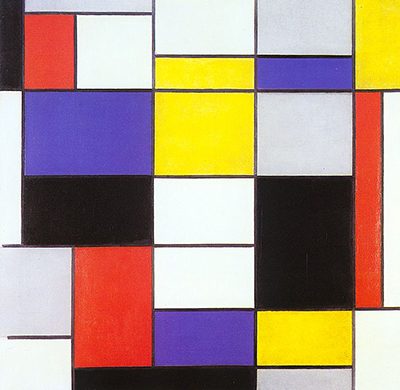Composition A is a 1923 painting by Piet Mondrian which can now be found within the permanent collection of the Galleria Nazionale d'Arte Moderna e Contemporanea (GNAM), Rome, Italy. The Italian capital tends to focus more on traditional art but there are some galleries, such as this one, which cover contemporary art instead.
Much of Mondrian's work remains in his native Netherlands, with plenty still on view to the public within a selection of small, provincial galleries. There is considerable interest in the early part of his career in which the artist focused on the landscapes of his nation, before then moving on. Indeed, many of his abstract paintings were inspired by the flat plains of this European nation but over time his work would become more and more separated from any connection to reality. By the point at which Composition A arrived he had already fully transitioned into an abstract artist of note and seemed comfortable in this new direction. It was now all about experimenting with different styles of abstract art, alternating between colours and shapes to create different balances within his paintings. He remains most famous for the style used in artworks such as Composition with Red, Blue and Yellow but the painting featured here offers an alternative approach which was busier and considerably more complex.
Within this artwork we find a more organised, consistent grid than in other abstract paintings by this artist. The vertical lines are fairly regular and whilst not being entirely equally spaced, they do help to produce a selection of similar shapes across the painting. There is not quite the same variety here as with other Mondrian works in terms of the size of forms, with the largest only being slightly wider than the average. The artist also chooses not to leave large areas blank in this iteration, making use of much more colour than normal and this helps to leave behind a particularly busy and bright artwork. One thing of note, though, is how he chooses to crop aggressively on the corners of the canvas, leaving many shapes cut off. There is also a line to the bottom left of the painting which falls short of the edge, leaving fills unbordered. Mondrian continued to work in this manner throughout the year and this body of work offers something slightly different within his overall movement into abstract art.
As mentioned, the Roman gallery in which Composition A from 1923 can be found is an important venue which offers something different to the cultural offering of this famous city. Most will seek out ancient antiquities and Renaissance art whilst visiting, but there is still a need to cater for those more interested in contemporary art which is particularly of note to the younger generations. Visitors to the Galleria Nazionale d'Arte Moderna will also be able to discover work from other major names such as Cezanne, Duchamp, Kandinsky, Rodin and Van Gogh, to name just a few. Within that, each one may have several different pieces representing them too, so there is plenty to see and enjoy here.




